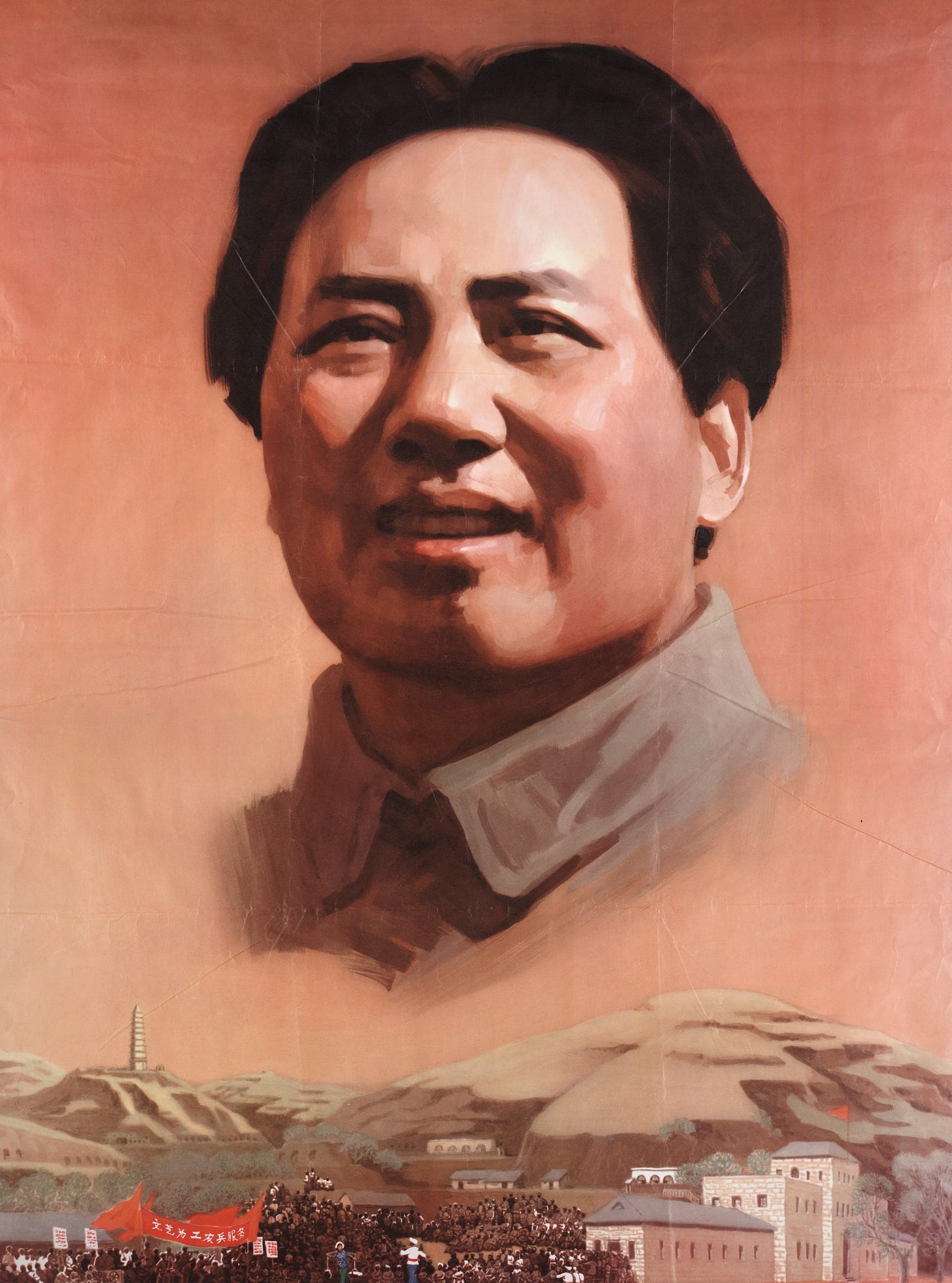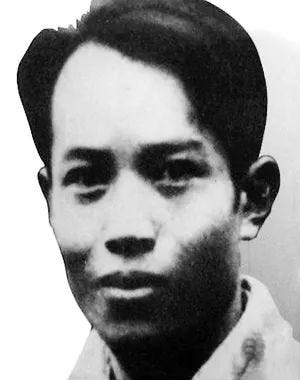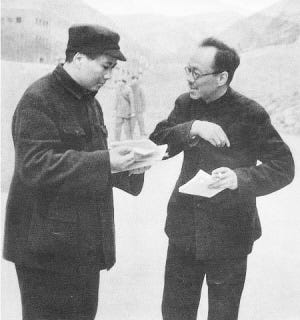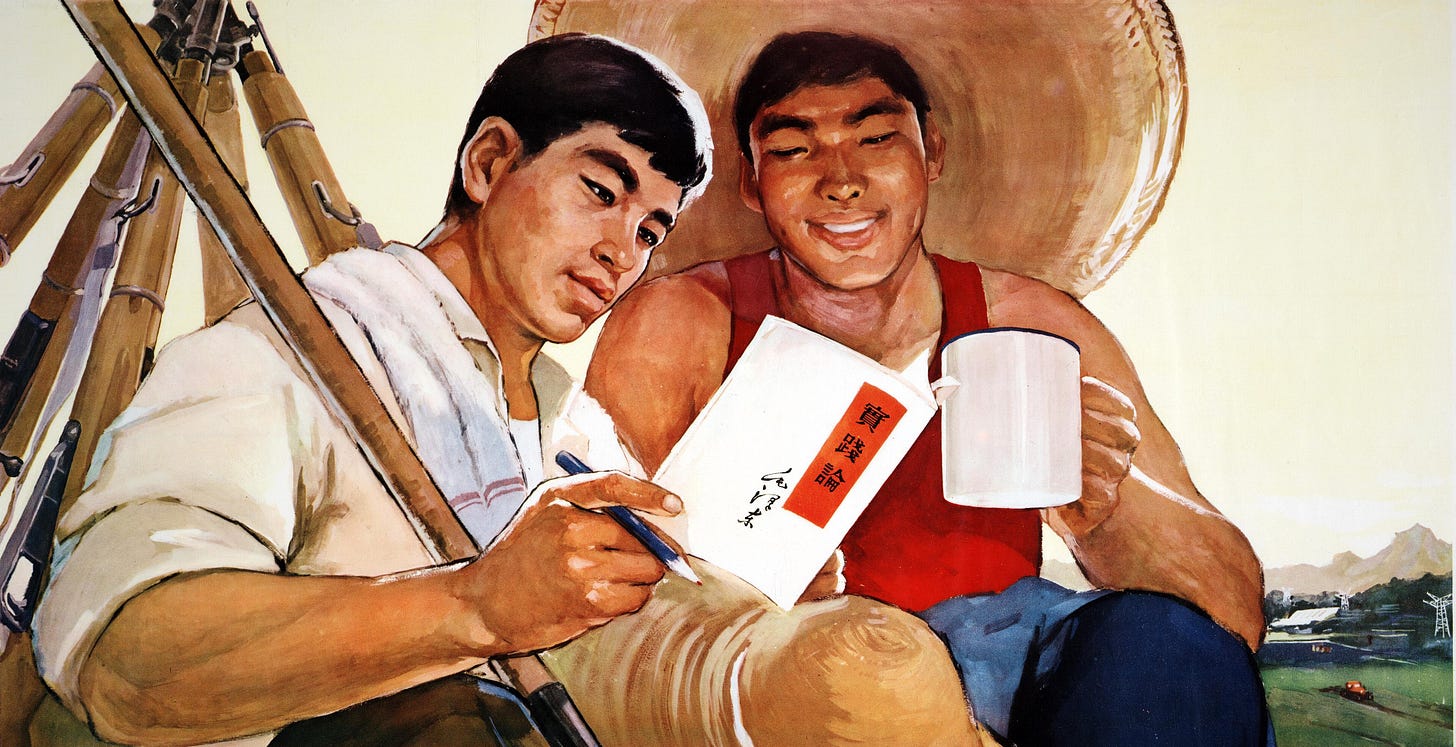By the early 1940s, the Communists in Yan’an were feeling relatively secure.
The Japanese advance in north China had not reached that area. The Sino-Japanese War and the United Front meant that Chiang Kai-shek’s main concern for the past few years had been Japan and not the Communist Party. The Nationalist Government in China had even funded the Communists in Yan’an. The Soviet Union provided support too.
Chongqing, the new Republic of China capital, was the most bombed city in the world as Japan focused its energy on Chiang Kai-shek.
For most of the war, Japan ignored Yan’an and rarely bombed it. The population there grew by perhaps 40,000. There were maybe 7000 locals. The locals and Communist Party members were physically separate and lived very different lives.
Even within the Communist Party membership in Yan’an, there was considerable separation and inequality. A canteen system was set up by 1937. Ordinary soldiers received the least food. Members of the highest standard of ordinary cadres received a mess standard worth three times as much as that of ordinary soldiers. In between those two groups, ordinary cadres received one dish and one soup. Politburo members like Mao Zedong received four dishes and one soup.
The Communist residents there were either survivors of the Long March or recent arrivals who wanted to live in the Communist Mecca. Some were long-time Communists who had fled Japanese controlled eastern China or Guomindang controlled territory. Pro-communist propaganda and stories from the United Front and the Anti-Japanese War made the Communist Party attractive to many young people and idealists. A stream of new members travelled to Yan’an and party membership grew.
The Communist Party leadership responded in a few ways. One was to carefully vet arrivals. Those who wanted to travel to the Communist base area had to undergo political vetting in Xi’an and in Yunyang Township. Only if they passed, were they allowed to proceed onto Yan’an. That was 400 kilometers from the last vetting location. Most would have to travel on foot, which took 9 or 10 days. Only older or prominent communists could travel by truck. The travel time allowed their report cards to reach Yan’an before the volunteers did.
Vetting appears to have been rigorous. For example, one person who had joined the Communist Party in 1928 was considered politically tainted because he had been arrested by the KMT and had signed a “statement of repentance” while in jail. He was allowed to travel to Yan’an and given work. But with a stain on his record for his historical problem. He felt a cold shoulder repeatedly in Yan’an and wanted to leave. But he was convinced to stay. Those who did not pass vetting were told to return to Nationalist controlled areas.
In Yan’an, the party established numerous schools. Among them were the Anti-Japanese Military and Political University, an Academy of the Arts, the Northwest Public School, the Central Party School, the Academy of Marxism-Leninism, the Women's University, Yan'an University, and the Academy of the Nationality, as well as special training programs. All party members had to be enrolled and educated in one of those institutions. That made it possible to re-educate every Communist there.
Mao was by now the leader in Yan’an. Wang Ming and Zhou Enlai, two Chinese Communists who had studied at Sun Yat-sen University in Moscow, operated by the Comintern, were more active in the United Front in Nationalist controlled China. Liu Shaoqi, who will become more important from now on, was leading the guerrilla campaigns in the red base areas in eastern China, primarily in areas of Japanese occupation.
Early on during the war with Japan, Mao described it as a War of Three Kingdoms. He wanted Japan and Chiang Kai-shek’s Republican government to exhaust each other. Mao wanted the Red Army to grow, conserve its strength and for the areas and people under control of the Communist Party to grow. Of course, he wanted to emerge on top at the end of this War of the Three Kingdoms.
In April 1941, the Soviet Union signed a Neutrality Pact with Japan, which included an acceptance that Japan controlled Manchukuo and north China. The Communist Party of China applauded it, even though that meant accepting Japan’s control of those areas of China. That disheartened many Chinese nationalists and idealists but was consistent with the Communist Party of China’s history. To that point, it had usually accepted direction from the Comintern and from Moscow. Chinese sovereignty had been secondary in the Party’s eyes to the survival of its patron, the first Communist country, and to the growth of communism.
But in June 1941, Hitler’s Germany attacked Stalin’s Soviet Union. As the German army groups penetrated further and further into the USSR and threatened Moscow itself by late 1941, Soviet attention was far more focused on survival of the world’s first Communist country. The Chinese Communists were, for now, more on their own.
It was during this period in Yan’an that Mao Zedong consolidated his power and remolded the Communist Party of China. This was also when, for the first time, a cult of personality around Chairman Mao began.
It is known as the Yan’an Rectification Campaign. It was the first major rectification campaign. There would be others.
While there was a preparatory phase before it, this Rectification Campaign really began on February 1, 1942, with Mao Zedong’s speech "Reform in Learning, the Party and Literature." Then a book entitled "Documents of the Rectification Campaign" was published and circulated. This book included essays such as Mao's "Combat Liberalism" and Liu Shaoqi's "How to be a Good Communist."
The goal was to unify the party's ideology, consolidate Mao's power, and rectify the thoughts and behaviors of party members. It aimed at correcting "incorrect" ideologies among the members through study sessions, criticism, and self-criticism, targeting those seen as opposed to Mao's views. Mao already had a leadership position in the party. Now he was to gain ideological control too. This was about thought control and making Mao above criticism.
One reason that Mao thought it necessary was because the membership of the party was growing. The United Front against Japan had legalized the Communist Party of China. Pro-communist propaganda during the United Front said that the Communist Party was committed to fighting Japan and building a happy utopia in Yan’an. This attracted new recruits as well as encouraged older communists to relocate to the northwest. Yan’an was no longer made up just of survivors of the Long March. The population of Communists in Yan’an was growing and becoming younger. By the 1940s, perhaps 90% of the Communists in Yan’an were new recruits, rather than survivors of the Long March. Mao, and the party generally, wanted control over these new arrivals.
There were some major risks that Mao and other leading Chinese Communists saw. One was ideological divergence. The arriving Communists had different ideas about what Communism meant, especially for China. As the Rectification process developed, Mao attacked both “dogmatism” and “empiricism”. Dogmatism was anything Mao considered to be too much about Marxist or Soviet ideology without taking the Chinese situation sufficiently into account. For example, since China had far more peasants than urban industrial workers, overreliance on Marxist ideas like the revolution of the urban proletariat were not helpful. Mao believed, and now his party believed, that peasants would be the force of the revolution.
But then to ensure that the pendulum didn’t swing too far the other way, "empiricists" were then criticized for prioritizing practical experience over ideological purity. They were accused of making decisions based on practical considerations rather than strict adherence to Marxist-Leninist theory. This attack on both sides left only Mao, and maybe a few trusted allies, as judge of what was proper and was neither too dogmatic nor too empirical.
Another risk was factionalism. Mao was most worried about the group of Chinese Communists who had studied together in Moscow at Sun Yat-sen University under Comintern sponsorship. I’ve previously referred to them as the 28 Bolsheviks. That made them targets, especially Wang Ming who was a potential rival to Mao. The Rectification Campaign included major criticism of Wang Ming and of factionalism.
As a leading member of the Chinese Communist Party who spent significant time in the Soviet Union, Wang Ming's approach to communism was more aligned with the Comintern's internationalist stance, which increasingly came into conflict with Mao Zedong's more nationalist and peasant-based approach. Wang Ming’s ideology and supporters were criticized and marginalized. This helped Mao to dominate Chinese communism.
To do so, and I quote an important book on this Rectification Campaign, Mao first "drew on the support of the liberal intellectuals in the Party to encircle and suppress the Soviet faction", then Mao reinstated the Soviet faction and used them to "to join with [Mao] in suppressing the remnants (the liberal intellectuals) of the 'May Fourth' influence in the Party."
In that second stage, May Fourth "notions of freedom, democracy, and individual liberation among Party intellectuals" were purged, in favour of "the leader and the collective above all, and the individual as negligible."
Zhou Enlai had studied in Europe and was close to the internationalist, Comintern allied wing of the party. But through self-criticisms and emphatic support for Mao, he managed to navigate the treacherous waters of the Rectification Campaign relatively well. He would continue to play a key role in the Communist Party and maintain his status by subordinating himself to Mao.
One clear victim of the Rectification Campaign was Wang Shiwei. Wang Shiwei was a Chinese journalist and literary writer. Born in 1906, he had studied at Peking University and joined the Communist Party of China in 1926. He can be associated with the May 4th Movement which was nationalist and intellectual. His trouble resulted from him writing Wild Lilies while writing for the Liberation Daily and living in Yan’an in the early 1940s. He criticized Mao’s taste for beautiful women. In Yan’an, Mao was onto his fourth wife, the beautiful Jiang Qing, a divorced actress who had been active in Shanghai’s film and theatre business. Not only did Wang Shiwei criticize Mao’s womanizing, but he also pointed out the privileges enjoyed by the party elite. He criticized the “big men” in Yan’an who were responsible for the “growth of darkness” in China. Mao ensured he was punished for speaking up and criticizing Mao. Wang Shiwei was expelled from the Party, accused of being a Trotskyite (meaning an enemy of Stalin) and disrupting party unity. He underwent a trial, was imprisoned, and executed in 1947. Wang Shiwei is a symbol of the dark side of the Rectification Campaign, of its repression of free speech or constructive criticism by Communist Party members and of the purge of threats to Mao.
Kang Sheng was a key figure in the Rectification Campaign, serving as Mao's chief of the secret police. He had risen to power in part by being one of the few to bless Mao’s fourth marriage. While many others told Mao not to marry Jiang because of her past and because Mao’s preference for his new love interest, over the mother of his children and loyal survivor of the Long March, rubbed many Communists the wrong way. Kang was helpful to Mao by destroying evidence of Madame Mao’s past and by vouching for her character. Kang also had been in Moscow with Wang Ming and knew Wang Ming’s secrets. Kang had also learned about Stalin’s secret police and purge techniques. He shared those for Mao’s benefit. Kang was a useful tool for Mao because Kang himself was vulnerable. Kang had an incorrect past where he had been arrested by the Nationalists and released by them. Such a past was enough to disqualify new arrivals from the trust of the party. But Mao allowed Kang to thrive and to serve him. Kang’s past meant that Mao could have him removed from power whenever it suited Mao. Kang did his best to never give Mao a reason to abandon him. Kang played a crucial role in identifying, investigating, and persecuting those deemed to have "incorrect" ideological views within the Chinese Communist Party. Kang's work significantly contributed to the campaign's intensity and the atmosphere of surveillance and fear.
During this Rectification Campaign, the term Mao Zedong Thought was introduced, and party members were required to study it and follow it. Today, similarly, all Communist Party cadres in China are required to study Xi Jinping Thought. Today’s campaign has its roots in Mao’s Yan’an Rectification Campaign.
The first Rectification Campaign involved intense study sessions, public criticism, and harsh scrutiny of one's thoughts and beliefs. Party members were required to write self-criticism of their failings, political mistakes and ideological deviations. They would then undergo public criticisms. In many cases, the self-criticisms weren’t considered strict enough and the party member had to start over and go deeper in self-criticism of previous thoughts, actions and beliefs. The campaign also involved confessions of relations and contacts with other party members and outsiders. This was to help combat factionalism by breaking down confidential relationships, secrets and communication outside of official channels. The goal was to forge a Communist 'New Man' who combined loyalty, obedience and a fighting spirit.
The campaign contributed to a cohesive and disciplined party organization, which played a crucial role in the subsequent civil war in China.
But in its last stages, the Rectification Campaign also led to accusations that thousands of the new arrivals were spies. These so-called spies were then persecuted, including sometimes to execution. First Mao encouraged this weeding out of spies and then after the purges, minimized how many spies there had really been. The purges, not only of Wang Shiwei, Wang Ming and other members of the 28 Bolsheviks, but also of many imagined spies, was a prelude to later Rectification Campaigns and to the eventual Cultural Revolution. This current, that continues today in the Communist Party’s investigation and imprisonment of party members for factionalism, can be seen as a direct line from Mao Zedong to Xi Jinping. It shows the length to which some leaders will go to maintain and strengthen their hold on power.
The Rectification Campaign started in Yan'an, the Communist base where the Long March had ended. Mao Zedong Thought emerged as a distinct ideological framework. It synthesized Marxism-Leninism with the specific conditions of China, emphasizing peasant-led revolution, guerrilla warfare, and the mass line approach to leadership and decision-making. Its principles and practices were eventually applied in other Communist controlled areas. The campaign's focus on ideological purity and consolidation of Mao Zedong's leadership had broad implications for the party, impacting members beyond Yan'an. And there was much happening outside of that one base area.
P.S. Did you know that The Chinese Revolution is on YouTube and is also a podcast?








